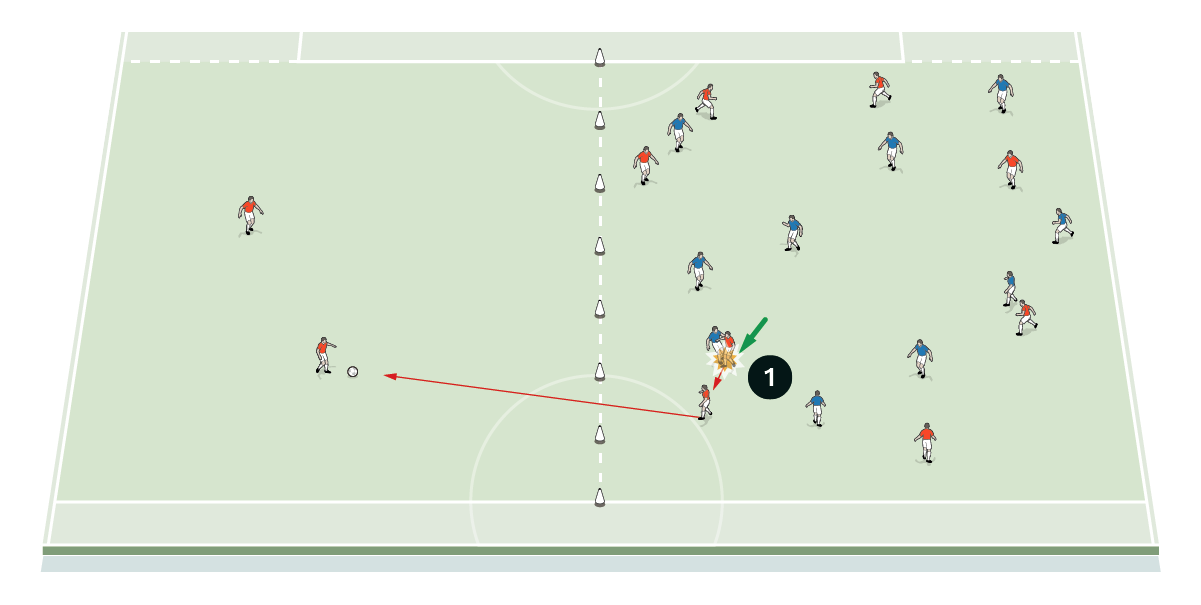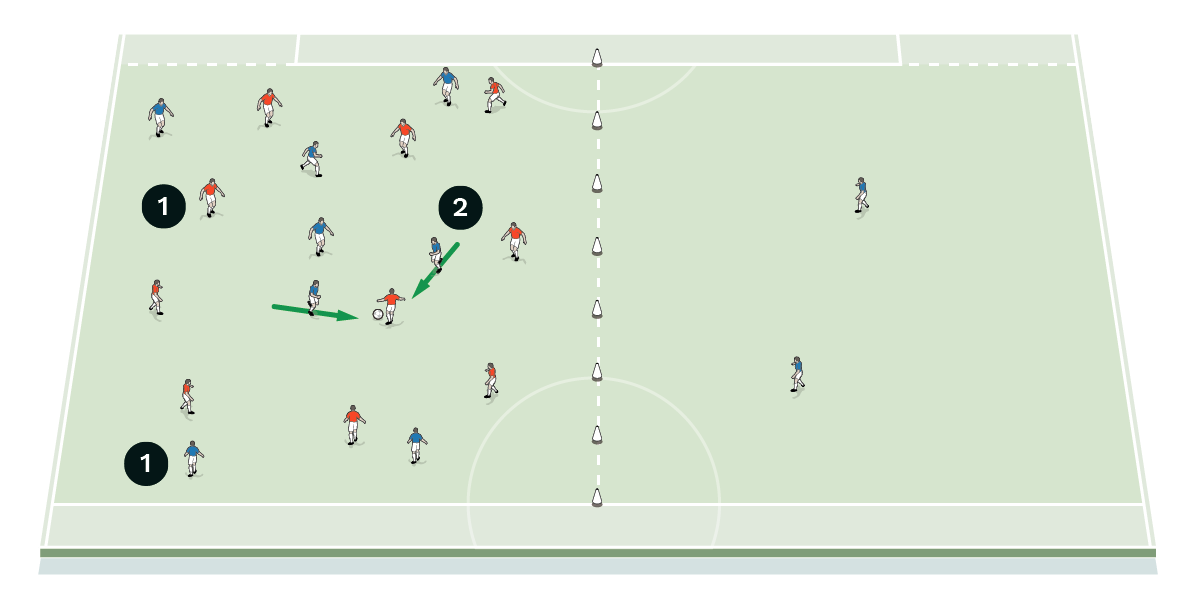You are viewing 1 of your 1 free articles
Counter-pressing
When you counter-press, you allow yourself to win the ball back and play as quick as possible forward to create a goal opportunity, or you can keep up the tempo of the game.
| Area | Anything up to a full pitch |
| Equipment |
2 full size goals |
| No. of Players | 20+2 goalkeepers |
| Session Time | At coach’s discretion |
Counter-pressing is very important. This is the time where you can really hurt the opposition team. When you counter-press, you allow yourself to win the ball back and play as quick as possible forward to create a goal opportunity, or you can keep up the tempo of the game. Counter-pressing helps you to save energy. You win the ball back very quickly and you stop the opposition’s rhythm, putting you in control.
In my time as a player, when I was at Liverpool we won a lot of games when we counter-pressed, able to make a quick pass because the opposition were disorganised. Now as a coach, we do a lot of counter-pressing drills, and win a lot of games. I think it’s a great tool to use for your team to win football matches.
I’d run this session early in the week. It’s a good habit for the team to get in to and you can run it again later in the week, increasing the area you’re working in.
“Counter-pressing is important: it helps you to save energy and puts you in control”
POSSESSION AND COUNTER-PRESS
Set up two teams, 9v9+2. The red team should look to keep possession, and counter-press when they lose the ball. When the blue team win the ball, they look to score in one of the mini goals, or they can get a point for making four passes.
We’re looking for good use of space, and a quick reaction to win the ball back after losing it. Players need strong communication, speed, and aggression. You can run this four times in two-minute bursts.
[1a]

-
Set up your teams as 9v9, with two floating players helping whichever team is out of possession
- Red team look to keep possession, blue team look to win the ball
[1b]

-
Blue team win the ball
- Blue team look to score in one of the mini goals while red team look to regain possession
TRANSFER GAME AND COUNTER-PRESSING
Set up as 10v8. The blue team starts with the ball. The red team are trying to win the ball. If the reds win the ball, the blues must win it back as quickly as possible. Meanwhile, the reds’ aim is to transfer it to the two players on the left side. If they do that, all of the reds move across to the left, with eight blue players, leaving two blues on the right-hand side. The blues now try to win the ball back from the reds, with the aim of transferring it to the two players on the right.
[2a]

-
Blue team starts with the ball. Red team are trying to win the ball
[2b]

-
Reds win the ball and transfer it to the two players on the left side
[2c]

-
All of the reds move across to the left, with eight blue players, leaving two blues on the right-hand side
- Blues now try to win the ball back from the reds, with the aim of transferring it to the two players on the right
11v11
Throughout this practice, the ball should always restart always with the red team in different places in the game. The coach serves the ball in from a different area of the pitch each time. In the last five minutes of the game, normal game rules apply, but both teams are looking to use their counter-pressing. The attacking team should be counter-pressing and looking to score, or keeping the ball and working it to penetrate and score.
[3]

-
Red team seeking to retain possession and score, blue team seeking to gain possession
“Both teams should use their counter-pressing”
COACHING POINTS
What are the key things to look out for?
The first thing is the reaction on losing the ball. The speed of the press is important. When you regain the ball, you must make the right pass, because if there’s an opportunity to score, you must take it. If there isn’t, you must get the ball and keep it, waiting for the right moment to penetrate.
What are the typical mistakes players might make and how do I avoid them?
Players can be a little bit lazy. If you have one player reacting and two or three others not reacting, it’s all over. That means you need players to have quick reactions together, responding as a unit, and ready and working to get the ball back as quickly as possible before the opposition switch the ball to the other side.
Related Files
Editor's Picks
Deep runs in the final third
Using the goalkeeper in build-up play
Pressing principles
Intensive boxes drill with goals
Penetrating the final third
Creating and finishing
My philosophy
Pressing initiation
Compact team movement
Coaches' Testimonials

Alan Pardew

Arsène Wenger

Brendan Rodgers

Carlos Carvalhal

José Mourinho

Jürgen Klopp

Pep Guardiola

Roy Hodgson

Sir Alex Ferguson

Steven Gerrard
Coaches' Testimonials

Gerald Kearney, Downtown Las Vegas Soccer Club

Paul Butler, Florida, USA

Rick Shields, Springboro, USA

Tony Green, Pierrefonds Titans, Quebec, Canada
Join the world's leading coaches and managers and discover for yourself one of the best kept secrets in coaching. No other training tool on the planet is written or read by the calibre of names you’ll find in Elite Soccer.
In a recent survey 92% of subscribers said Elite Soccer makes them more confident, 89% said it makes them a more effective coach and 91% said it makes them more inspired.
Get Monthly Inspiration
All the latest techniques and approaches
Since 2010 Elite Soccer has given subscribers exclusive insight into the training ground practices of the world’s best coaches. Published in partnership with the League Managers Association we have unparalleled access to the leading lights in the English leagues, as well as a host of international managers.
Elite Soccer exclusively features sessions written by the coaches themselves. There are no observed sessions and no sessions “in the style of”, just first-hand advice delivered direct to you from the coach.








